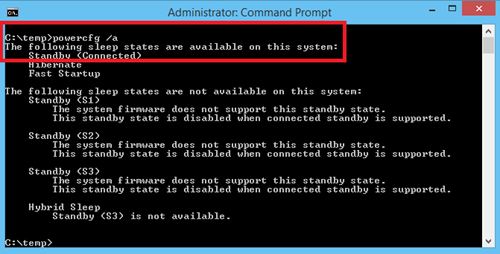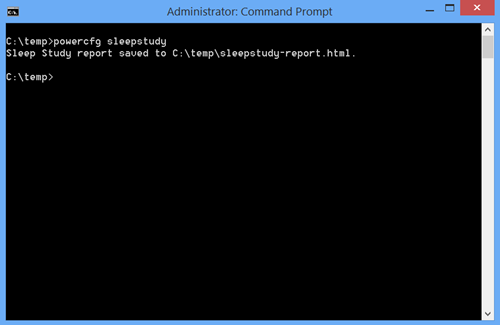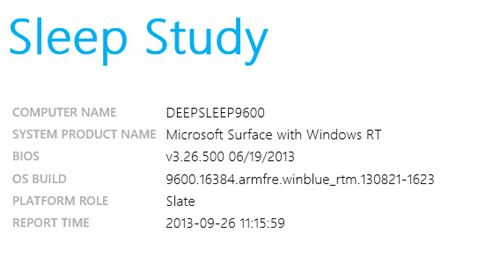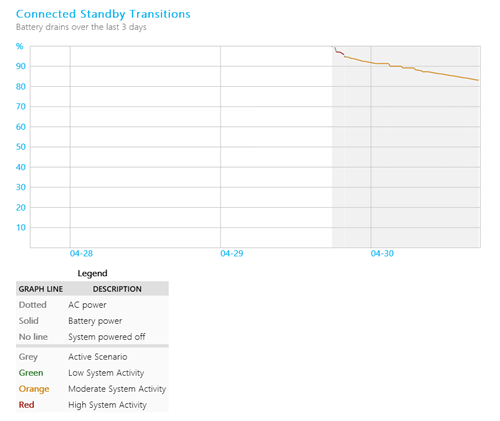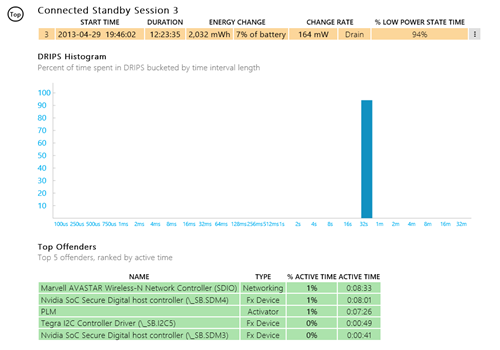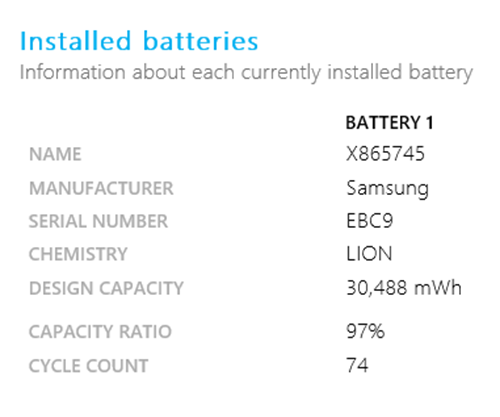In my last post, I introduced you to InstantGo (previous to Windows 8.1, we called this Connected Standby), a new power model used on some Windows 8.x systems. InstantGo is a tight integration of software (firmware, drivers, OS) with System on Chip (“SoC”) hardware to provide a sleep mode with long battery life and a connected, instant-on user experience.
In this post, I’d like to introduce you to Sleep Study, a new tool available on Windows 8.x systems with InstantGo that can help you identify sources of battery drain that occurred while the PC was in sleep mode (that is, when the screen was off).
Sleep Study tells you how well the system slept and how much activity it experienced during that time. While in the sleep state, the system is still doing some work, albeit at a lower frequency. Because the resulting battery drain is not easily perceptible (you can’t see it draining), we built the Sleep Study tool in Windows 8.1 to allow you to track what is happening. We thought of simply using traditional logging to do this, but ironically, the logging itself would drain the battery. With this in mind, we designed the Sleep Study tool to minimize its own impact on battery life, while tracking the battery draining activities.
The Sleep Study report
You can use Sleep Study to see which apps and devices are most active during a sleep session. Sleep Study reviews all the sleep sessions longer than 10 minutes and provides you with a report that color codes each session according to its power consumption. A session is defined as the period from Screen Off to Screen On. In cases when the system is plugged into AC power, the policies are less stringent than when on battery power. While the tool still tracks connected standby activity on AC power, it is more useful to identify unexpected drains on battery, or DC power.
To help you easily identify apps, devices and services with higher power consumption, these are highlighted in red or orange in the report, and represent opportunities to extend your battery life.
In this video, we walk you through a typical Sleep Study report.
Determining if you have InstantGo support
Sleep Study is a Windows 8.1 utility that only runs on systems that support InstantGo. You can determine if your hardware and software support InstantGo by entering powercfg /a into a Command Prompt window, and then looking to see if Standby (Connected)is included in the list of sleep states:
Running Sleep Study
The Sleep Study tool is an option passed to powercfg. You need to run it from an elevated cmd window to have it generate a sleepstudy-report.html in the current directory. In summary, the requirements for running Sleep Study are:
- Admin rights
- Windows 8.1 or newer system
- InstantGo support
Note that in this example, I created “C:temp” in advance so a non-admin user would be able to open the resulting sleepstudy-report.html in a browser.
Loading the HTML report
The Sleep Study HTML output, sleepstudy-report.html, can be loaded in any browser.
The HTML is created in the current directory. We recommend you run the command in a non-system directory. For example, instead of the default c:windowssystem32, use a non-system directory such as c:temp. This step is recommended, but optional if you’re an admin. Keep in mind that non-admin users won’t be able to access the report unless it is in a non-system directory.
Sections within the report
The Sleep Study HTML output is designed so you can easily read and interpret it. The sections are:
- Machine information
- Battery drain chart
- Chart Legend
- Connected standby session summary table
- Connected standby session 1
- Session #1 summary
- Top 5 duration activities
- Detailed breakdown of sub components
- Connected standby session 2
- (Repeat for each subsequent session).
- Battery information
Next, I’ll go through each section in detail.
Machine information
Note the report time: Sleep Study will look back up to 3 days for connected standby sessions. You can use “powercfg /sleepstudy /?” to see additional command line options.
Battery drain chart
- Green lines are well performing sessions
- Orange lines are moderate performing sessions
- Red lines are poor performing sessions
- Dotted Lines are on AC (wall charger)
- Solid lines are on DC (battery)
Connected standby session summary table
- Sessions are numbered sequentially
- START TIME is in YYYY-MM-DD HH:MM:SS, using 24-hour format
- State is a hyperlink to the session, in this case, all connected standby sessions
- DURATION is in HH:MM:SS. Durations under 10 minutes are filtered out of this report
- ENERGY CHANGE is in milli-watts per hour and as % of battery capacity
- CHANGE RATE is in mW over an hour interval
- “Charge/Drain” determines if it was an AC or DC session. Drain is DC; Charge is AC.
- % LOW POWER STATE TIME is the % of time spent in Deepest Runtime Idle Platform State (DRIPS %)
- Some systems may also have an analogous hardware state for DRIPS %
Per session details
- Per Session Summary repeats the above vital statistics.
- The top 5 offenders are listed in terms of duration.
- Detailed information on:
- Activator (Software component)
- Device (hardware component)
- PDC phases (connected standby system activity)
- Networking (In depth breakdown of networking durations by NDIS clients)
- Histogram of duration between CPU wake periods
- Periods of 32 seconds or longer are optimal for battery savings
Advanced statistics are displayed by clicking the three dots in the rightmost gray box. The statistics shown in the resulting list vary according to system capabilities.
High-drain sleep sessions
Some connected standby sessions are expected to have activity that results in battery drain. Examples where we expect higher than average drain include:
- Getting and installing Windows Update while the system sleeps
- Having peripherals plugged into the USB port (hubs, disks, keyboards, mice, network adapters)
- Having Bluetooth connected devices while the screen is off
- Playing music with the screen off
- Poor WLAN environment or unreliable network connections
- High network activity (Skype calls, emails, downloads)
- Short sleep sessions that don’t allow the system to settle into idle
- Having a poorly behaving device driver
- Other low-level software bugs in drivers, firmware, or system services
We allow the system to support the experiences you care about, but with the Sleep Study tool, now you can better understand the associated battery drain. You can then make an informed decision around battery costs of certain activities. Of course, it’s also a relatively user friendly tool you can use to isolate any unexpected battery drains.
Battery information
- DESIGN CAPACITY tells you the size of the battery, in this case close to 30.5 watt hours (or 30,488 milliwatt hours)
- CAPACITY RATIO tells you how much energy can be stored in the battery before it is considered full.
- If low, the battery will have shorter battery life due to reduced capacity (for example, if the battery chemistry degrades)
- Drain rates are based on percentage of (Design Capacity * Capacity Ratio)
Additional Sleep Study options:
Here are a few additional options available to you:
Sleep Study is a very useful tool to track your battery drain while in sleep mode on an InstantGo capable system. We’ve provided this powerful visual tool to help both PC manufacturers and end users better understand the subtle ways in which different activities can affect battery life. If you try out Sleep Study on your Windows 8.1 InstantGo system, let us know how it goes!

